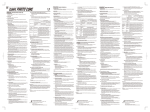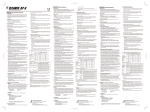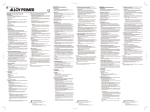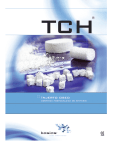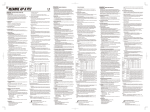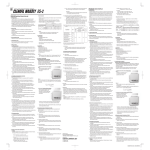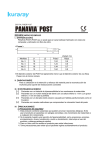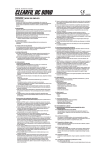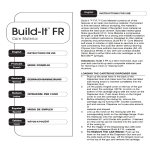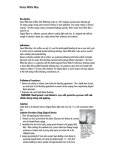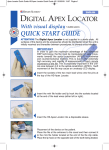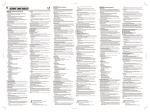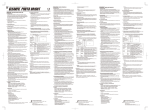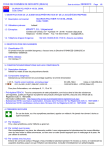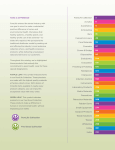Download clearfil™ photo core plt (en,fr,es,it,nl,de)
Transcript
003 C366-EU1 FRANÇAIS MODE D'EMPLOI LIGHT-CURE CORE BUILD-UP COMPOSITE MATERIAL Jetez l'embout après usage et stérilisez le distributeur conformément au mode d'emploi du distributeur. Le produit polymérise sous une lampe d'opération ou la lumière naturelle (rayons du soleil). Gardez à l'abri d'une lampe d'opération ou de la lumière naturelle et utilisez dans les 5 minutes suivant la dispersion. I. INTRODUCTION CLEARFIL PHOTO CORE PLT est un matériau de reconstruction de moignons composite photopolymérisable et radiopaque associé à un système de distribution spécial pour un positionnement rapide. 2. Placement Incremental placement and light-curing each increment is strongly recommended especially in deep cavities. 3. Curing Cure the resin with a dental curing unit. Hold the emitting tip as close to the resin as possible. The light curing time and depth of cure for each dental curing unit is used is shown below. ENGLISH INSTRUCTIONS FOR USE I. INTRODUCTION CLEARFIL PHOTO CORE PLT is a light-cure, radiopaque core build-up composite material with a special dispensing system for quick placement. II. INDICATION Core build-up of vital or non-vital tooth III. CONTRAINDICATION Patients with a history of hypersensitivity to methacrylate monomers IV. INCOMPATIBILITY Do not use eugenol containing materials for pulp protection or temporary sealing, since the eugenol could retard the bonding system curing process. V. PRECAUTIONS 1. Safety precautions 1. Avoid use of the product for patients with a history of hypersensitivity to methacrylate monomers. 2. If any hypersensitivity occurs, such as dermatitis, discontinue use of the product and consult a physician. 3. Wear gloves or take other appropriate protective measures to prevent the occurrence of hypersensitivity that may result from contact with methacrylate monomers. 4. Use caution to prevent the product from coming in contact with the skin or getting into the eye. Before using the product, cover the patient’s eyes with a towel to protect the patient’s eyes from splashing material. 5. If the product comes in contact with human body tissues, take the following actions; <If the product gets in the eye> Immediately wash the eye with copious amounts of water and consult a physician. <If the product comes in contact with the skin> Immediately wipe it off with a cotton pledget moistened with alcohol or gauze and wash with copious amounts of water. 6. Use caution to prevent the patient from accidentally swallowing the product. 7. Avoid looking directly at the dental curing unit when curing the product. 8. For infection control reasons, PLT tips are for single use only. 2. Handling and manipulation precautions 1. Do not use the product in conjunction with the other composite resins. Mixing materials may cause a change in physical properties, possibly a decrease, from the properties expected. 2. When light curing the product, note the depth of cure in this instructions for use. 3. The product polymerize under an operating light or natural light (sunlight from windows). Avoid operating light or natural light, and use within 5 minutes from dispensing. 4. The emitting tip of the dental curing unit should be held as near and vertical to the resin surface as possible. If a large resin surface is to be light cured, it is advisable to divide the area into several sections and light-cure each section separately. 5. Low intensity of light causes poor adhesion. Check the lamp for service life and the dental curing unit guide tip for contamination. It is advisable to check the dental curing light intensity using an appropriate light evaluating device at appropriate intervals. 6. Squeeze the dispenser with a slow, steady pressure. Excessive force is not necessary. 7. The use of the product is restricted to a licensed dental professional. 3. Storage precautions 1. The product must be used by the expiration date indicated on the package. 2. Keep away from extreme heat or direct sunlight. 3. The product must be stored at 10- 25ºC /50-77ºF when not in use. 4. Do not refrigerate or store at low temperature. If the product is refrigerated or stored at a low temperature, it will become excessively soft. 5. The product must be stored in proper places where only dental practitioners can access it. VI. COMPONENTS 1) Components Please see the outside of the package for contents and quantity. 2) Ingredients Principal ingredients: ・Silanated silica filler ・Silanated barium glass filler ・Bisphenol A diglycidylmethacrylate (Bis-GMA) ・Triethyleneglycol dimethacrylate ・dl-Camphorquinone The total amount of inorganic filler is approx. 68vol%. The particle size of inorganic fillers ranges from 0.49 to 75 μm.. VII. CLINICAL PROCEDURES A. CORE BUILD-UP OF VITAL TOOTH A-1. Cleaning tooth structure Be sure the cavity is adequately cleaned. An adequately cleaned cavity assures maximum adhesive performance. A-2. Moisture control Avoid contamination of the treatment area from saliva or blood to produce optimal results. A rubber dam is recommended to keep the tooth clean and dry. A-3. Cavity preparations Remove any infected dentin and prepare the cavity in the usual manner. A-4. Pulp protection Any actual or near pulp exposure could be covered with a hard setting calcium hydroxide material. There is no need for cement lining or basing. Do not use eugenol materials for pulp protection. A-5. Applying a matrix strip and wedges Apply a matrix strip and wedges as needed. A-6. Tooth surface treatment and bonding Tooth surface treatment and bonding should be performed according to the Instructions for Use of the bonding system used (e.g. CLEARFIL TRI-S BOND or CLEARFIL SE BOND). Light curing time and depth of cure Dental curing unit Conventional halogen* depth of cure Fast halogen* Plasma arc* LED* 5 sec. Light curing time 10 sec. 20 sec. 40 sec. − − 3.5mm 4.0mm 4.0mm − − 5.0mm 4.5mm 6.0mm − − − − 4.0mm 4.5mm *Dental curing unit Type Light source Fast halogen Halogen lamp Light intensity2) of more than 550 mW/cm2 in wavelength range from 400 - 515 nm Plasma arc Xenon lamp Light intensity3) of more than 2000 mW/cm2 in wavelength range from 400 - 515 nm, and light intensity of more than 450 mW/cm2 in wavelength range from 400 - 430 nm. LED Blue LED1) Light intensity2) of more than 300 mW/cm2 in wavelength range from 400 - 515 nm Conventional Halogen lamp halogen Wavelength range and light intensity Light intensity2) of 300 - 550 mW/cm2 in wavelength range from 400 - 515 nm 1) Peak of emission spectrum: 450 - 480 nm 2) Evaluated according to ISO 10650-1. 3) Wavelength distribution and light intensity values measured with a spectro-radiometer calibrated using an IEC or the NIST (National Institute of Standards and Technology) standard lamp A-8. Preparation of the abutment tooth After curing the composite resin, prepare the abutment tooth. B. CORE BUILD-UP OF NON-VITAL TOOTH B-1. Cleaning tooth structure Be sure the cavity is adequately cleaned. An adequately cleaned cavity assures maximum adhesive performance. B-2. Moisture control Avoid contamination of the treatment area from saliva or blood to produce optimal results. A rubber dam is recommended to keep the tooth clean and dry. B-3. Cleaning cavity and preparing root canal Remove the temporary sealing material from the cavity and filling material from the root canal. Using a Pizo reamer, prepare and clean the root canal opening. B-4. Try-in of the post A post of the proper diameter is fitted to the prepared root canal and the length of the post adjusted. Sand blast the post as needed. B-5. Either B-5a or B-5b B-5a. When PANAVIA F 2.0 is used. Cement the post into the root canal according to the Instructions for Use of PANAVIA F 2.0. [NOTE] Do not use CLEARFIL SE BOND when PANAVIA F 2.0 is used. Since PANAVIA F 2.0 plays the role as adhesive bonding agent, apply excess PANAVIA F 2.0 paste to the remaining tooth structure on which ED PRIMER II, a component of PANAVIA F 2.0 is applied and the surface of the post. B-5b. When another resin luting cement is used. Cement the post into the root canal according to the Instructions for Use of the resin luting cement. B-6. Placement and light curing of CLEARFIL PHOTO CORE PLT 1. Dispensing Place a PLT tip of the product into the dispenser barrel according to the Instructions for Use of the dispenser. The tip may be rotated to provide the proper angle for delivery into the cavity. [CAUTION] Squeeze the dispenser with a slow, steady pressure. Excessive force is not necessary. Discard the tip after use and sterilize the dispenser according to the instructions for use of the dispenser. The product polymerize under an operating light or natural light (sunlight from windows). Avoid operating light or natural light, and use within 5 minutes from dispensing. 2. Build-up Using appropriate instruments, build-up the resin to the appropriate anatomy being careful to avoid incorporation of air bubbles. Incremental placement and light-curing each increment is strongly recommended. 3. Curing Refer to “Light curing time and depth of cure” in A-7. B-7. Preparation an abutment tooth After curing the composite resin, prepare the abutment tooth. [WARRANTY] Kuraray Noritake Dental Inc. will replace any product that is proved to be defective. Kuraray Noritake Dental Inc. does not accept liability for any loss or damage, direct, consequential or special, arising out of the application or use of or the inability to use these products. Before using, the user shall determine the suitability of the products for the intended use and the user assumes all risk and liability whatsoever in connection therewith. [NOTE] “CLEARFIL”, “CLEARFIL PHOTO CORE”, “SE BOND”, “CLEARFIL TRI-S BOND” and “PANAVIA” are trademarks of KURARAY CO.,LTD. IV. INCOMPATIBILITÉ Ne pas utiliser de matériaux à base d'eugénol pour une protection de la pulpe ou un scellement temporaire, car l'eugénol pourrait retarder le processus de polymérisation du système de collage. V. PRÉCAUTIONS 1. Mesures de sécurité 1. N’utilisez pas le produit chez les patients présentant une hypersensibilité aux monomères de méthacrylate. 2. Si une hypersensibilité se déclare, telle une dermatite, interrompez l’utilisation du produit et consultez un médecin. 3. Portez des gants ou prenez d’autres mesures de protection nécessaires pour éviter une hypersensibilité pouvant être causée par tout contact avec les monomères de méthacrylate. 4. Prenez les mesures nécessaires pour éviter que le produit ne soit en contact avec la peau ou les yeux. Avant d’utiliser le produit, protégez les yeux du patient à l’aide d’une serviette afin d’éviter toute projection de matériaux. 5. Si le produit entre en contact avec tout tissu humain, procédez comme suit : <Si le produit est en contact avec l’œil> Lavez immédiatement et abondamment l’œil à l’eau et consultez un ophtalmologiste. <Si le produit est en contact avec la peau> Épongez immédiatement avec un tampon de coton imbibé d’alcool ou de la gaze, puis rincez abondamment à l’eau. 6. Prenez les mesures nécessaires pour éviter que le patient n’avale accidentellement le produit. 7. Évitez de regarder directement l'appareil de polymérisation dentaire lorsque vous polymérisez le produit. 8. Afin de contrôler les infections, les embouts PLT sont à usage unique. 2. Précautions relatives à l’utilisation et à la manipulation 1. N' utilisez pas le produit avec d'autres résines composites. Le mélange de matériaux peut modifier les propriétés physiques et éventuellement diminuer les performances escomptées. 2. Lors de la photopolymérisation du produit, notez la profondeur de la polymérisation dans ce mode d'emploi. 3. Le produit polymérise sous une lampe d'opération ou une lumière naturelle (rayons du soleil). Gardez à l'abri d'une lampe d'opération ou de la lumière naturelle et utilisez dans les 5 minutes suivant la dispersion. 4. La pointe émettrice de l'appareil de polymérisation dentaire doit être maintenue aussi perpendiculaire à la surface de résine et aussi près que possible de la surface de résine. Si la surface de résine à photopolymériser est grande, il est préférable de diviser la zone en plusieurs sections et de photopolymériser chaque section séparément. 5. Si l'intensité de la lumière est trop faible, cela peut entraîner une mauvaise adhérence. Vérifiez la durée de vie de la lampe et examinez la pointe émettrice de l'appareil de polymérisation dentaire afin de vous assurer de l'absence de toute contamination. Il est recommandé de vérifier l'intensité de la lampe de l'appareil de polymérisation à l'aide d'un appareil de mesure de l'intensité approprié à des intervalles réguliers. 6. Appuyez sur le distributeur lentement et de manière constante. Une pression excessive est inutile. 7. Le produit ne peut être utilisé que par un dentiste professionnel autorisé. 3. Précautions de stockage 1. Le produit doit être utilisé avant la date d’expiration indiquée sur l’emballage. 2. Ne pas exposer à une chaleur extrême et aux rayons directs du soleil. 3. Le produit doit être stocké à 10 – 25 ºC / 50 – 77 ºF lorsqu'il n'est pas utilisé. 4. Ne pas placer au réfrigérateur ou stocker à basse température. Si le produit est placé au réfrigérateur ou stocké à basse température, il se ramollira fortement. 5. Le produit doit être stocké dans un lieu prévu à cet effet auquel seuls des dentistes professionnels ont accès it. VI. COMPOSANTS 1) Composants Veuillez vous reporter à l’extérieur de l’emballage pour plus d'informations sur le contenu et les quantités. 2) Ingrédients Ingrédients principaux : ・Matériau de remplissage de silice silanisé ・Verre de barium silanisé ・Bisphénol A diglycidyleméthacrylate (Bis-GMA) ・Triéthylèneglucol diméthacrylate ・dl-Quinone camphrée La quantité totale de matériau inorganique de remplissage est d'environ 68 vol %. La dimension des particules inorganiques de remplissage va de 0,49 à 75 μm. VII. PROCÉDURES CLINIQUES A. RECONSTITUTION DE MOIGNONS AU NIVEAU DES DENTS VITALES A-1. Nettoyage de la structure de la dent Assurez-vous que la cavité est correctement nettoyée. Une cavité propre garantit une performance d'adhérence optimale. A-2. Contrôle de l'humidité Pour des résultats optimaux, évitez toute contamination de la zone de traitement par de la salive ou du sang. Une digue en caoutchouc est recommandée pour garder la dent propre et sèche. A-3. Préparations de la cavité Retirez toute dentine infectée et préparez la cavité comme d'habitude. A-4. Protection de la pulpe La pulpe dentaire ou les zones proches de la pulpe dentaire exposées devront être couvertes à l'aide d'un matériau à base d'hydroxyde de calcium de prise dure. Aucun revêtement ou base de ciment n'est nécessaire. N'utilisez pas de matériaux à base d'eugénol pour protéger la pulpe. A-6. Traitement de la surface de la dent et collage Le traitement de la surface de la dent et le collage doivent être effectués conformément au mode d'emploi du système de collage utilisé (par exemple, CLEARFIL TRI-S BOND ou CLEARFIL SE BOND). 1621 Sakazu, Kurashiki, Okayama 710-0801, Japan Kuraray Europe GmbH Philipp-Reis-Str. 4, 65795 Hattersheim am Main, Germany Phone:+49 (0)69 305 35 840 Fax:+49 (0)69 305 35 640 2. Pose La pose incrémentale et la photopolymérisation de chaque incrément sont fortement recommandées, notamment pour les cavités profondes. 3. Polymérisation Polymérisez la résine avec un appareil de polymérisation dentaire. Maintenez la pointe émettrice le plus près possible de la résine. Le temps de photopolymérisation et la profondeur de la polymérisation pour chaque appareil de polymérisation dentaire utilisé sont indiqués ci-dessous. III. CONTRE-INDICATION Patients ayant des antécédents d’hypersensibilité aux monomères de méthacrylate A-5. Application d'une bande de matrice et de clavettes Appliquez au besoin une bande de matrice et des clavettes. A-7. Placement and light curing of CLEARFIL PHOTO CORE PLT 1. Dispensing Place a PLT tip of the product into the dispenser barrel according to the Instructions for Use of the dispenser. The tip may be rotated to provide the proper angle for delivery into the cavity. [CAUTION] Squeeze the dispenser with a slow, steady pressure. Excessive force is not necessary. Discard the tip after use and sterilize the dispenser according to the dispenser instructions for use. The product polymerize under an operating light or natural light (sunlight from windows). Avoid operating light or natural light, and use within 5 minutes from dispensing. II. INDICATION Reconstitution de moignons au niveau des dents vitales ou avitales A-7. Pose et photopolymérisation de CLEARFIL PHOTO CORE PLT 1. Dispersion Placez un embout PLT du produit dans le tube de distribution conformément au mode d'emploi du distributeur. L'embout peut être pivoté pour déposer le produit dans la cavité dans le bon angle. [PRÉCAUTION] Appuyez sur le distributeur lentement et de manière constante. Une pression excessive est inutile. Temps de photopolymérisation et profondeur de polymérisation Appareil de polymérisation dentaire Halogène conventionnel* profondeur de polymérisation Halogène rapide* Arc de plasma* LED* Temps de photopolymérisation 5 sec. 10 sec. 20 sec. 40 sec. − − 4,0mm 5,0mm 4,5mm 6,0mm − − 3,5mm 4,0mm − − − − 4,0mm 4,5mm *Appareil de polymérisation dentaire Type Source de lumière Halogène Lampe conventionnel halogène Halogène Lampe rapide halogène Arc de plasma LED Plage de longueurs d’onde et intensité lumineuse Intensité lumineuse2) de 300 - 550 mW/cm2 dans la plage de longueurs d’onde de 400 - 515 nm Intensité lumineuse2) supérieure à 550 mW/cm2 dans la plage de longueurs d’onde de 400 - 515 nm Intensité lumineuse3) supérieure à 2000 mW/cm2 Lampe au dans la plage de longueurs d’onde de 400 - 515 xénon nm et intensité lumineuse supérieure à 450 mW/cm2 dans la plage de longueurs d’onde de 400 - 430 nm. LED Intensité lumineuse2) supérieure à 300 mW/cm2 1) bleue dans la plage de longueurs d’onde de 400 - 515 nm 1) Spectre des émissions maximales : 450 - 480 nm 2) Évalué conformément à la norme ISO 10650-1. 3) Gamme d’ondes et valeurs de l’intensité lumineuse mesurées avec un spectroradiomètre calibré en utilisant une lampe standard IEC ou la lampe standard du NIST (National Institute of Standards and Technology) A-8. Préparation de la dent d'appui Après polymérisation de la résine composite, préparez la dent d'appui. B. RECONSTITUTION DE MOIGNONS AU NIVEAU DES DENTS AVITALES B-1. Nettoyage de la structure de la dent Assurez-vous que la cavité est correctement nettoyée. Une cavité propre garantit une performance d'adhérence optimale. B-2. Contrôle de l'humidité Pour des résultats optimaux, évitez toute contamination de la zone de traitement par de la salive ou du sang. Une digue en caoutchouc est recommandée pour garder la dent propre et sèche. B-3. Nettoyage de la cavité et préparation du canal radiculaire Retirez le matériau de scellement temporaire de la cavité et le matériau d'obturation du canal radiculaire. À l'aide de l'alésoir Pizo, préparez et nettoyez l'ouverture du canal radiculaire. B-4. Essai du tenon Un tenon de bon diamètre est adapté au canal radiculaire préparé et la longueur du tenon est ajustée. Sablez le tenon si nécessaire. B-5. B-5a ou B-5b B-5a. Avec PANAVIA F 2.0. Collez le tenon dans le canal radiculaire conformément au mode d'emploi de PANAVIA F 2.0. [NOTA] N'utilisez pas CLEARFIL SE BOND avec PANAVIA F 2.0. PANAVIA F 2.0 jouant le rôle d'un agent de collage adhésif, appliquez l'excédent de pâte PANAVIA F 2.0 sur le reste de la structure de la dent où vous avez appliqué ED PRIMER II, un composant de PANAVIA F 2.0, et sur la surface du tenon. B-5b. Avec un autre liant résineux obturant. Collez le tenon dans le canal radiculaire conformément au mode d'emploi du liant résineux obturant. B-6. Pose et photopolymérisation de CLEARFIL PHOTO CORE PLT 1. Dispersion Placez un embout PLT du produit dans le tube de distribution conformément au mode d'emploi du distributeur. L'embout peut être pivoté pour déposer le produit dans la cavité dans le bon angle. [PRÉCAUTION] Appuyez sur le distributeur lentement et de manière constante. Une pression excessive est inutile. Jetez l'embout après usage et stérilisez le distributeur conformément au mode d'emploi du distributeur. Le produit polymérise sous une lampe d'opération ou la lumière naturelle (rayons du soleil). Gardez à l'abri d'une lampe d'opération ou de la lumière naturelle et utilisez dans les 5 minutes suivant la dispersion. 2. Reconstitution À l'aide des instruments appropriés, reconstituez la résine de la forme adaptée en prenant soin d'éviter la formation de bulles d'air. La pose incrémentale et la photopolymérisation de chaque incrément sont fortement recommandées. 3. Polymérisation Reportez-vous au temps de photopolymérisation et à la profondeur de la polymérisation au chapitre A-7. B-7. Préparation d'une dent d'appui Après polymérisation de la résine composite, préparez la dent d'appui. III. CONTRAINDICACIONES Pacientes con historial de hipersensibilidad a los monómeros de metacrilato IV. INCOMPATIBILIDADES No utilizar materiales que contengan eugenol para la protección de la pulpa o el sellado provisional dado que el eugenol puede retrasar el proceso de polimerización del sistema adhesivo. VI. PRECAUCIONES 1. Precauciones de seguridad 1. Evitar utilizar el producto en pacientes con un historial de hipersensibilidad a los monómeros de metacrilato. 2. Si el paciente muestra una reacción de hipersensibilidad, tal como dermatitis, interrumpir la utilización del producto y consultar a un médico. 3. Utilizar guantes o adoptar las medidas protectoras pertinentes para evitar la aparición de hipersensibilidad como resultado del contacto con los monómeros de metacrilato. 4. Tener precaución y evitar el contacto del producto con la piel o los ojos. Antes de utilizar el producto, cubrir los ojos del paciente con una toalla para protegerlos de las salpicaduras del material. 5. Adoptar las siguientes medidas si el producto entra en contacto con los tejidos humanos: <Si el producto entra en los ojos> Enjuagar inmediatamente los ojos con abundante agua y consultar a un médico. <Si el producto entra en contacto con la piel> Limpiar inmediatamente con una compresa de algodón humedecida con alcohol o gasa y aclarar con abundante agua. 6. Tener precaución para evitar que el paciente trague accidentalmente el producto. 7. Evitar mirar directamente a la lámpara de polimerización al polimerizar el producto. 8. Las puntas PLT son de un solo uso para evitar infecciones. 2. Precauciones de manejo y manipulación 1. No utilizar el producto en combinación con otra resina compuesta. La mezcla de materiales puede provocar un cambio en las propiedades físicas, probablemente una reducción en las propiedades previstas. 2. Tener presente la profundidad de polimerización facilitada en las presentes Instrucciones de uso al fotopolimerizar el producto. 3. El producto polimeriza con luz de trabajo o natural (luz procedente de ventanas). Evitar la luz de trabajo o natural y utilizar antes de que transcurran 5 minutos desde su dispensado. 4. La punta de emisión de la lámpara de polimerización debe mantenerse lo más próxima y vertical posible con respecto a la superficie de la resina. Si se va a fotopolimerizar una superficie de resina de grandes dimensiones, se recomienda dividir la zona en diversas secciones y fotopolimerizar cada una de ellas por separado. 5. Una baja intensidad de luz provoca una mala adhesión. Comprobar la vida útil de la lámpara y la presencia de contaminación en la punta guía de la misma. Se recomienda controlar la intensidad de luz de la lámpara de polimerización con la periodicidad apropiada sirviéndose de un comprobador de luz adecuado. 6. Apretar el dispensador aplicando una presión suave y constante. No es necesario aplicar una fuerza excesiva. 7. El producto será utilizado únicamente por un profesional dental autorizado. 3. Precauciones de almacenamiento 1. No utilizar el producto una vez transcurrida la fecha de caducidad indicada en el envase. 2. Mantener alejado de fuentes de calor extremo o de la luz solar directa. 3. Conservar el producto a 10 – 25 ºC / 50 – 77 ºF cuando no se utilice. 4. No refrigerar o conservar a bajas temperaturas. El producto resultará demasiado blando si se refrigera o conserva a bajas temperaturas. 5. El producto debe almacenarse en lugares adecuados donde únicamente los dentistas puedan manipularlo. VI. COMPONENTES 1) Componentes Consultar el exterior del envase para conocer el contenido y las cantidades. 2) Ingredientes Ingredientes principales: ・Empaste de silicio silanado ・Empaste de vidrio de bario silanado ・Diglicidilmetacrilato A bisfenol (Bis-GMA) ・Dimetacrilato trietileneglicol ・Alcanforquinona dl La cantidad total de relleno inorgánico es de aproximadamente 68vol%. El tamaño de partícula de los rellenos inorgánicos oscila entre 0,49 y 75 μ m. VII. PROCEDIMIENTOS CLÍNICOS A. RECONSTRUCIÓN DEL MUÑÓN DE UN DIENTE VITAL A-1. Limpieza de la estructura del diente Asegurarse de que la cavidad está debidamente limpia. Una cavidad sometida a una limpieza correcta garantiza una máxima adhesión. A-2. Control de la humedad Evitar que la zona a tratar se contamine con saliva o sangre para garantizar unos óptimos resultados. Se recomienda el empleo de un dique de goma para mantener el diente limpio y seco. A-3. Preparación de la cavidad Retirar la dentina infectada y preparar la cavidad de la forma habitual. A-4. Protección pulpar Cubrir cualquier zona de exposición de la pulpa o próxima a la misma con un material de hidróxido de calcio de fraguado duro. No es necesaria una base o revestimiento de cemento. No utilizar productos que contengan eugenol para la protección de la pulpa. A-5. Utilización de una tira matriz y cuñas Utilizar una tira matriz y cuñas según se requiera. [NOTA] “CLEARFIL”, “CLEARFIL PHOTO CORE”, “SE BOND”, “CLEARFIL TRI-S BOND” et “PANAVIA” sont des marques de la société KURARAY CO.,LTD. A-7. Aplicación y fotopolimerización de CLEARFIL PHOTO CORE PLT 1. Dispensado Colocar una punta PLT del producto en el interior del cilindro distribuidor de acuerdo con las Instrucciones de uso del dispensador. Rotar la punta para obtener el ángulo adecuado para aplicar el producto en la cavidad. Kuraray Europe GmbH Philipp-Reis-Str. 4, 65795 Hattersheim am Main, Germany Phone:+49 (0)69 305 35 840 Fax:+49 (0)69 305 35 640 2. Aplicación Se recomienda una técnica de aplicación incremental y la fotopolimerización de cada capa, especialmente en el caso de cavidades profundas. 3. Polimerización Polimerizar la resina con una lámpara de fotopolimerización. Mantener la punta de emisión de luz lo más cerca posible de la resina. A continuación se especifica el tiempo de fotopolimerización y la profundidad de polimerización de cada lámpara. II. ÁMBITOS DE APLICACIÓN Reconstrucción de muñones de dientes vitales o no vitales [GARANTIE] Kuraray Noritake Dental Inc. remplacera tout produit manifestement défectueux. Kuraray Noritake Dental Inc. décline toute responsabilité pour toute perte ou dommage, direct ou indirect, résultant de l’application ou utilisation non conforme de ces produits. Avant utilisation, l’utilisateur déterminera si les produits conviennent pour l’utilisation prévue, et l’utilisateur assumera tous les risques et responsabilités découlant de l’utilisation. 1621 Sakazu, Kurashiki, Okayama 710-0801, Japan que transcurran 5 minutos desde su dispensado. ESPAÑOL MODO DE EMPLEO I. INTRODUCCIÓN CLEARFIL PHOTO CORE PLT es un material compuesto de núcleo radiopaco con un sistema dispensador especial para una colocación más rápida. A-6. Tratamiento de la superficie del diente y adhesión El tratamiento de la superficie del diente y la adhesión deben realizarse de conformidad con las Instrucciones de uso del sistema adhesivo utilizado (por ejemplo, CLEARFIL TRI-S BOND o CLEARFIL SE BOND). [PRECAUCIÓN] Apretar el dispensador aplicando una presión suave y constante. No es necesario aplicar una fuerza excesiva. Desechar la punta después de su utilización y esterilizar el dispensador de acuerdo con sus instrucciones de uso. El producto polimeriza con luz de trabajo o natural (luz procedente de ventanas). Evitar la luz de trabajo o natural y utilizar antes de Tiempo de fotopolimerización y profundidad de polimerización Tiempo de fotopolimerización Lámpara de polimerización 10 s 20 s 40 s 5s Halógena convencional* Profundidad de polimerización Halógena rápida* Arco de plasma* LED* − − 4,0mm 5,0mm 4,5mm 6,0mm − − 3,5mm 4,0mm − − − − 4,0mm 4,5mm *Lámpara de polimerización Fuente Espectro de longitud de onda e intensidad de luz Tipo de luz Lámpara Intensidad de luz2) de 300 - 550 mW/cm2 con un Halógena convencional halógena espectro de longitud de onda de 400 - 515 nm Halógena Lámpara Intensidad de luz2) superior a 550 mW/cm2 con un rápida halógena espectro de longitud de onda de 400 - 515 nm Arco de plasma Lámpara de xenón LED LED1) azul Intensidad de luz3) superior a 2000 mW/cm2 con un espectro de longitud de onda de 400 - 515 nm e intensidad de luz superior a 450 mW/cm2 con un espectro de longitud de onda de 400 - 430 nm. Intensidad de luz2) superior a 300 mW/cm2 con un espectro de longitud de onda de 400 - 515 nm 1) Pico de espectro de emisión: 450 - 480 nm 2) Evaluada conforme a ISO 10650-1. 3) Valores de distribución de longitud de onda e intensidad de luz medidos con un espectroradiómetro calibrado utilizando una lámpara convencional conforme a IEC o NIST (Instituto Nacional de Normas y Tecnología) A-8. Preparación del diente pilar Preparar el diente pilar tras la polimerización de la resina compuesta. B. RECONSTRUCIÓN DEL MUÑÓN DE UN DIENTE NO VITAL B-1. Limpieza de la estructura del diente Asegurarse de que la cavidad está debidamente limpia. Una cavidad sometida a una limpieza correcta garantiza una máxima adhesión. B-2. Control de la humedad Evitar que la zona a tratar se contamine con saliva o sangre para garantizar unos óptimos resultados. Se recomienda el empleo de un dique de goma para mantener el diente limpio y seco. B-3. Limpieza de la cavidad y preparación del canal radicular Quitar el material sellador provisional de la cavidad y el material de relleno del canal radicular. Preparar y limpiar la abertura del canal radicular con un escariador piezoeléctrico. B-4. Colocación del poste Colocar un poste del diámetro adecuado en el canal radicular preparado y ajustar la longitud del mismo. Arenar el poste según se requiera. B-5. B-5a o B-5b B-5a. Cuando se utiliza PANAVIA F 2.0. Cementar el poste en el canal radicular según las Instrucciones de uso de PANAVIA F 2.0. [NOTA] No utilizar CLEARFIL SE BOND cuando se usa PANAVIA F 2.0. Dado que PANAVIA F 2.0 actúa como agente adhesivo, aplicar el exceso de pasta PANAVIA F 2.0 a la estructura del diente restante en la que se aplica ED PRIMER II, un componente de PANAVIA F 2.0, y a la superficie del poste. B-5b. Cuando se utiliza otro cemento de resina. Cementar el poste en el canal radicular según las Instrucciones de uso del cemento de resina. B-6. Aplicación y fotopolimerización de CLEARFIL PHOTO CORE PLT 1. Dispensado Colocar una punta PLT del producto en el interior del cilindro distribuidor de acuerdo con las Instrucciones de uso del dispensador. Rotar la punta para obtener el ángulo adecuado para aplicar el producto en la cavidad. [PRECAUCIÓN] Apretar el dispensador aplicando una presión suave y constante. No es necesario aplicar una fuerza excesiva. Desechar la punta después de su utilización y esterilizar el dispensador de acuerdo con sus instrucciones de uso. El producto polimeriza con luz de trabajo o natural (luz procedente de ventanas). Evitar la luz de trabajo o natural y utilizar antes de que transcurran 5 minutos desde su dispensado. 2. Aplicación Aplicar la resina con la forma apropiada sirviéndose del instrumental adecuado con cuidado de evitar la formación de burbujas de aire. Se recomienda una técnica de aplicación incremental y la fotopolimerización de cada capa. 3. Polimerización Consultar el tiempo de fotopolimerización y la profundidad de polimerización que figuran en A-7. B-7. Preparación del diente pilar Preparar el diente pilar tras la polimerización de la resina compuesta. [GARANTÍA] Kuraray Noritake Dental Inc. reemplazará aquellos productos que se demuestre que están defectuosos. Kuraray Noritake Dental Inc. no acepta ninguna responsabilidad por pérdidas o daños, directos, consecuentes o especiales, que se deriven de la aplicación o uso de estos productos o de la imposibilidad para utilizar los mismos. Antes de utilizar los productos, el usuario determinará la idoneidad de los mismos para el fin previsto y asumirá todos los riesgos y responsabilidades en relación con el mismo. [NOTA] “CLEARFIL”, “CLEARFIL PHOTO CORE”, “SE BOND”, “CLEARFIL TRI-S BOND” y “PANAVIA” son marcas de KURARAY CO.,LTD. 1621 Sakazu, Kurashiki, Okayama 710-0801, Japan Kuraray Europe GmbH Philipp-Reis-Str. 4, 65795 Hattersheim am Main, Germany Phone:+49 (0)69 305 35 840 Fax:+49 (0)69 305 35 640 luce operativa o alla luce naturale (luce del sole dalle finestre). Evitare di lavorare alla luce operativa o alla luce naturale e utilizzare il prodotto entro 5 minuti dall’erogazione. ITALIANO ISTRUZIONI PER L’USO I. INTRODUZIONE CLEARFIL PHOTO CORE PLT è un materiale composito per la costruzione del nucleo, fotopolimerizzante, radiopaco, con uno speciale sistema di erogazione per una rapida applicazione. 2. Collocazione È consigliato procedere per collocazione dei incrementi e fotopolimerizzazione di ogni incremento, specialmente nelle cavità profonde. 3. Polimerizzazione Polimerizzare la resina con un’unità di fotopolimerizzazione dentale. Tenere la punta ad emissione luminosa il più vicino possibile alla resina. Qui di seguito sono riportati il periodo di fotopolimerizzazione e la profondità di polimerizzazione per ogni unità di fotopolimerizzazione dentale. II. INDICAZIONI Costruzione di monconi per denti vitali e non vitali III. CONTROINDICAZIONI Pazienti con una storia di ipersensibilità verso i monomeri metacrilati IV. INCOMPATIBILITÀ Non usare materiali contenenti eugenolo per la protezione della polpa o per sigillature temporanee, perché l’eugenolo potrebbe ritardare il processo di polimerizzazione del sistema legante. VI. PRECAUZIONI 1. Precauzioni di sicurezza 1. Evitare di usare il prodotto su pazienti con una storia di ipersensibilità verso i monomeri metacrilati. 2. Se si presenta ipersensibilità, ad esempio con una dermatite, interrompere l’uso del prodotto e consultare un medico. 3. Indossare guanti o prendere appropriate misure protettive per evitare l’insorgere di ipersensibilità che potrebbe derivare dal contatto con i monomeri metacrilati. 4. Prestare attenzione affinché il prodotto non venga a contatto con la pelle o con gli occhi. Prima di utilizzare il prodotto, coprire gli occhi del paziente con un panno e proteggere gli occhi del paziente contro eventuali schizzi di materiale. 5. Se il prodotto viene a contatto con i tessuti del corpo umano, intraprendere le seguenti misure: <Se il prodotto entra negli occhi> Lavare immediatamente l’occhio con abbondante acqua e consultare un medico. <Se il prodotto entra in contatto con la pelle> Rimuovere immediatamente il materiale utilizzando un tampone di cotone inumidito con alcol o garza, quindi lavare con abbondante acqua. 6. Prestare la massima attenzione affinché il paziente non rischi di ingoiare accidentalmente il prodotto. 7. Evitare di guardare direttamente l’unità di polimerizzazione dentale, durante il relativo trattamento del prodotto. 8. Per motivi legati al controllo delle infezioni, le punte PLT sono monouso. 2. Precauzioni d'uso e di manipolazione 1. Non utilizzare il prodotto in combinazione con le altre resine composite. Una miscela dei materiali potrebbe causare una modifica delle proprietà fisiche, con possibile riduzione delle proprietà attese. 2. Durante la fotopolimerizzazione del prodotto, osservare la profondità di polimerizzazione indicate nelle presenti istruzioni d’uso. 3. Il prodotto polimerizza sotto una luce operativa o alla luce naturale (luce del sole dalle finestre). Evitare di lavorare alla luce operativa o alla luce naturale e utilizzare il prodotto entro 5 minuti dall’erogazione. 4. La punta ad emissione luminosa dell’unità di fotopolimerizzazione deve essere tenuta il più vicino e il più verticale possibile rispetto alla superficie in resina. Se deve essere fotopolimerizzare una grande superficie in resina, si consiglia di suddividere l’area in diverse sezioni, da fotopolimerizzare ciascuna separatamente. 5. Una bassa intensità della luce causa una scarsa adesione. Verificare la durata utile della lampadina ed esaminare la punta guida dell’unità di fotopolimerizzazione dentale per eventuali tracce di contaminazione. Si consiglia di controllare regolarmente l’intensità della luce di polimerizzazione dentale utilizzando un appropriato dispositivo di valutazione. 6. Schiacciare il dispenser con una pressione lenta e costante. Non è necessario impiegare eccessiva forza. 7. L'utilizzo del prodotto è riservato esclusivamente a professionisti del settore. 3. Precauzioni di conservazione 1. Usare il prodotto entro la data di scadenza specificata sulla confezione. 2. Tenere lontano da calore estremo e dalla luce solare diretta. 3. Il prodotto deve essere conservato ad una temperatura compresa fra 10 - 25 ºC / 50 - 77 ºF se non utilizzato. 4. Non refrigerare o conservare il prodotto a bassa temperatura. Se il prodotto vine refrigerato o conservato a bassa temperatura diventa eccessivamente molle. 5. Il prodotto deve essere conservato in luoghi idonei, cui abbiano accesso esclusivamente professionisti del settore. VI. COMPONENTI 1) Componenti Si prega di guardare l’esterno della confezione per verificare contenuti e quantità. 2) Ingredienti Ingredienti principali: ・Riempitivo in silice silanizzata ・Riempitivo in vetro di bario silanizzato ・Bisfenolo A diglicidilmetacrilato (Bis-GMA) ・Trietileneglicoldimetacrilato ・dl-Canforochinone La quantità complessiva di filler inorganici è di ca. 68vol%. La dimensione delle particelle dei filler inorganici va da 0,49 a 75 μm.. VII. PROCEDURE CLINICHE A. COSTRUZIONE DEL MONCONE DI UN DENTE VITALE A-1. Pulizia della struttura del dente Accertarsi che la cavità sia adeguatamente pulita. Una cavità adeguatamente pulita garantisce la massima resa di adesione. A-2. Controllo dell’umidità Per ottenere i risultati migliori, evitare di contaminare l’area da trattare con saliva o sangue. Per mantenere il dente pulito e asciutto si consiglia l’impiego di una diga in gomma. A-3. Preparazioni della cavità Rimuovere tutta la dentina infetta e preparare la cavità in base alla consueta procedura. A-4. Protezione della polpa Ogni area esposta della polpa o nei pressi della polpa può essere coperta con un materiale a base di idrossido di calcio rigido. Non sono necessari rivestimenti o basi in cemento. Non utilizzare materiali a base di eugenolo per la protezione della polpa. A-5. Applicazione di striscia e cunei interdentali Applicare una striscia interdentale e cunei, in base alle necessità. A-6. Trattamento della superficie dentale e bonding Il trattamento della superficie dentale e l’applicazione di agenti leganti devono essere eseguiti in base alle Istruzioni d’uso per il sistema legante utilizzato (ad esempio, CLEARFIL TRI-S BOND o CLEARFIL SE BOND). A-7. Collocazione e fotopolimerizzazione di CLEARFIL PHOTO CORE PLT 1. Erogazione Collocare una punta PLT del prodotto nel flacone del dispenser in base alle Istruzioni d'uso del dispenser. La punta può essere ruotata per avere l’angolo idoneo di erogazione nella cavità. [ATTENZIONE] Schiacciare il dispenser con una pressione lenta e costante. Non è necessario impiegare eccessiva forza. Smaltire la punta dopo l’uso e sterilizzare il dispenser in base alle istruzioni per l’uso del dispenser. Il prodotto polimerizza sotto una Periodo di fotopolimerizzazione e profondità di polimerizzazione Unità di Periodo di fotopolimerizzazione fotopolimerizzazione 5 sec. 10 sec. 20 sec. 40 sec. dentale Alogena convenzionale* Profondità di polimerizzazione Alogena rapida* Arco al plasma* LED* − − 3,5mm 4,0mm 4,0mm 4,5mm − − − − 4,0mm 4,5mm 5,0mm − 6,0mm − *Unità di Fotopolimerizzazione dentale Fonte Tipo Gamma lunghezza d’onda e intensità luminosa luminosa Alogena Lampada Intensità luminosa2) 300 - 550 mW/cm2 nella convenzionale alogena gamma di lunghezza d’onda 400 - 515 nm Alogena Lampada Intensità luminosa2) superiore a 550 mW/cm2 rapida alogena nella gamma di lunghezza d’onda 400 - 515 nm Arco al plasma LED Intensità luminosa3) superiore a 2000 mW/cm2 Lampada nella gamma di lunghezza d’onda 400 - 515 nm, allo xeno e intensità luminosa superiore a 450 mW/cm2 nella gamma di lunghezza d’onda 400 - 430 nm Intensità luminosa2) superiore a 300 mW/cm2 1) LED blu nella gamma di lunghezza d’onda 400 - 515 nm 1) Picco dello spettro di emissione: 450 - 480 nm 2) Valutazione in conformità con ISO 10650-1. 3) Valori della distribuzione delle lunghezze d’onda e dell’intensità luminosa misurati con uno spettroradiometro tarato utilizzando un lampada standard IEC o the NIST (National Institute of Standards and Technology) A-8. Preparazione del dente dell’abutment Dopo la polimerizzazione della resina composita, preparare il dente dell’abutment. B. COSTRUZIONE DEL MONCONE DI UN DENTE DEVITALIZZATO B-1. Pulizia della struttura del dente Accertarsi che la cavità sia adeguatamente pulita. Una cavità adeguatamente pulita garantisce la massima resa di adesione. B-2. Controllo dell’umidità Per ottenere i risultati migliori, evitare di contaminare l’area da trattare con saliva o sangue. Per mantenere il dente pulito e asciutto si consiglia l’impiego di una diga in gomma. B-3. Pulizia della cavità e preparazione del canale radicolare Rimuovere il materiale sigillante temporaneo dalla cavità e il materiale di riempimento dal canale radicolare. Utilizzando un Pizo reamer, preparare e pulire l’apertura del canale radicolare. B-4. Prova del perno Nel canale radicolare pronto viene inserito un perno di adeguato diametro e ne viene regolata la lunghezza. Sabbiare il perno quanto basta. B-5. B-5a o B-5b B-5a. Quando si utilizza PANAVIA F 2.0. Cementare il perno nel canale radicolare in base alle Istruzioni per l’uso di PANAVIA F 2.0. [NOTA] Non utilizzare CLEARFIL SE BOND quando si impiega PANAVIA F 2.0. Siccome PANAVIA F 2.0 svolge il ruolo di agente legante adesivo, applicare la pasta PANAVIA F 2.0 in eccesso sulla struttura rimanente del dente su cui è applicato ED PRIMER II, un componente di PANAVIA F 2.0, e sulla superficie del perno. B-5b. Quando si utilizza un altro cemento di lavorazione resina. Cementare il perno nel canale radicolare in base alle Istruzioni per l’uso del cemento di lavorazione resina. B-6. Collocazione e fotopolimerizzazione di CLEARFIL PHOTO CORE PLT 1. Erogazione Collocare una punta PLT del prodotto nel flacone del dispenser in base alle Istruzioni d'uso del dispenser. La punta può essere ruotata per avere l’angolo idoneo di erogazione nella cavità. [ATTENZIONE] Schiacciare il dispenser con una pressione lenta e costante. Non è necessario impiegare eccessiva forza. Smaltire la punta dopo l’uso e sterilizzare il dispenser in base alle istruzioni per l’uso del dispenser. Il prodotto polimerizza sotto una luce operativa o alla luce naturale (luce del sole dalle finestre). Evitare di lavorare alla luce operativa o alla luce naturale e utilizzare il prodotto entro 5 minuti dall’erogazione. 2. Costruzione Utilizzando strumenti idonei, preparare la resina dando la corretta forma anatomica, cercando di evitare di incorporare bolle d’aria. Si consiglia vivamente di collocare gli incrementi e fotopolimerizzare ogni incremento. 3. Polimerizzazione Fare riferimento a “Periodo di fotopolimerizzazione e profondità di polimerizzazione” in A-7. B-7. Preparazione di un dente dell’abutment Dopo aver polimerizzato la resina composita, preparare il dente dell’abutment. NEDERLANDS GEBRUIKSAANWIJZING III. TEGENAANGEWEZEN Patiënten met een voorgeschiedenis van overgevoeligheid voor methacrylaatmonomeren IV. INCOMPATIBILITEIT Geen eugenolhoudende materiaal ter bescherming van de pulpa of het voorlopig verzegelen gebruiken, omdat eugenol het uithardingsproces van het hechtsysteem zou kunnen vertragen. V. VOORZORGSMAATREGELEN 1. Veiligheidsmaatregelen 1. Vermijd het product bij patiënten met een gekende voorgeschiedenis van overgevoeligheid voor methacrylaatmonomeren. 2. Indien de patiënt een overgevoeligheidsreactie zoals dermatitis vertoont moet u het gebruik van het product stopzetten en medische hulp inroepen. 3. Draag handschoenen of neem andere aangepaste beschermingsmaatregelen om het optreden van overgevoeligheid te voorkomen, die kan voortvloeien uit contact met methacrylaatmonomeren. 4. Zorg ervoor dat het product niet in contact komt met de huid of in de ogen terechtkomt. Voordat u het product gebruikt, moet u de ogen van de patiënt met een doek beschermen tegen mogelijke spatten van het materiaal. 5. Indien het product in contact komt met menselijke lichaamsweefsels, moet u de volgende stappen ondernemen; <Indien het product in de ogen terechtkomt> Onmiddellijk de ogen met overvloedig veel water spelen en een arts raadplegen. <Indien het product in contact met de huid komt> Onmiddellijk het product wegvegen met een wattenschijfje, bevochtigd met alcohol, of gaas en vervolgens overvloedig spoelen met water. 6. Wees voorzichtig om te voorkomen dat de patiënt het product per ongeluk inslikt. 7. Tijdens het uitharden van het product niet rechtstreeks in het polymerisatieapparaat kijken. 8. Om infecties te vermijden, zijn de PLT-toppen enkel bedoeld voor eenmalig gebruik. 2. Voorzorgen voor verwerking en manipulatie 1. Gebruik het product niet samen met andere composietkunststoffen. Het mengen van materialen kan veranderingen van de fysieke eigenschappen veroorzaken, die mogelijk afbreuk doet aan de verwachte eigenschappen. 2. Waneer u het product met licht behandelt, moet u in deze gebruiksinformatie de uithardingsdiepte nalezen. 3. Het product polymeriseert onder operatielicht of natuurlijk licht (zonlicht via de ramen). Vermijd operatielicht of natuurlijk licht en gebruik binnen de 5 minuten na het uitduwen. 4. De uitgifteopening van het polymerisatieapparaat moet zo dicht en verticaal mogelijk tegen het kunststofoppervlak worden geplaatst. Indien een groot kunststofoppervlak moet worden behandeld met licht is het aangewezen het gebied in verschillende secties te verdelen en de secties afzonderlijk met licht te behandelen. 5. Een lage lichtintensiteit veroorzaakt een slechte hechting. Controleer de levensduur van de lamp en de uitgifteopening van het polymerisatieapparaat op contaminatie. Het is aangewezen om regelmatig de lichtintensiteit van het polymerisatieapparaat te controleren met een aangepast toestel voor lichtbeoordeling. 6.Druk op de dispenser met een trage, gelijkmatige druk. U hoeft niet overdreven veel kracht uit te oefenen. 7.Het gebruik van het product is voorbehouden aan gediplomeerde tandheelkundigen. 3. Voorzorgsmaatregelen voor bewaring 1. Het product moet gebruikt worden voor de vervaldatum op de verpakking. 2. Houd uit de buurt van extreme warmte of rechtstreeks zonlicht. 3. Het product moet bewaard worden bij 10 - 25 ºC /50 - 77 ºF wanneer het niet gebruikt wordt. 4. Niet koelen of bewaren bij een lage temperatuur. Indien het product wordt gekoeld of bij een lage temperatuur wordt bewaard, wordt het extreem zacht. 5. Het product moet worden bewaard op de juiste plaats, waar enkel tandartsen er toegang toe hebben. VI. COMPONENTEN 1) Componenten Lees de buitenkant van de verpakking voor de inhoud en hoeveelheid. 2) Ingrediënten Belangrijkste ingrediënten: ・Gesilaneerd silica-vuller ・Gesilaneerd barium glas-vuller ・Bisphenol A diglycidylmethacrylaat (Bis-GMA) ・Triethyleneglycol dimethacrylaat ・dl-Camphorquinone De totale hoeveelheid anorgane vuller bedraagt ong. 68 vol%. De partikelgrootte van anorgane vullers varieert van 0,49 tot 75 μm. VII. KLINISCHE PROCEDURES A. KERNOPBOUW VAN LEVENDE TAND A-1. Reinigen van de tandstructuur Zorg ervoor dat de caviteit goed gereinigd is. Een goed gereinigde caviteit zorgt voor een maximale hechting. A-2. Vochtcontrole Vermijd contaminatie van het behandelingsgebied met speeksel of bloed voor optimale resultaten. Een cofferdam is aanbevolen om de tand schoon en droog te houden. A-3. Voorbereiding van de caviteit Verwijder eventuele geïnfecteerde dentine en bereid de caviteit op de gewoonlijke manier voor. A-4. Pulpbescherming Elke directe of indirecte pulpaexpositie moet met een vast uithardend calcium-hydroxidemateriaal worden afgedekt. Er is geen cementlaag of basis nodig. Gebruik geen eugenolmaterialen voor pulpbescherming. [NOTA] ”CLEARFIL”, ”CLEARFIL PHOTO CORE”, ”SE BOND”, ”CLEARFIL TRI-S BOND” e ”PANAVIA” sono marchi di KURARAY CO.,LTD. A-6. Behandeling van het tandoppervlak en hechting De behandeling van het tandoppervlak en de hechting moeten worden uitgevoerd volgens de gebruiksinformatie van het gebruikte hechtingssysteem (bijv. CLEARFIL TRI-S BOND of CLEARFIL SE BOND). Kuraray Europe GmbH Philipp-Reis-Str. 4, 65795 Hattersheim am Main, Germany Phone:+49 (0)69 305 35 840 Fax:+49 (0)69 305 35 640 2. Plaatsing De geleidelijke plaatsing en lichtbehandeling van elke laag wordt sterk aanbevolen, vooral bij diepe caviteiten. 3. Uitharding Uithard de kunststof met een tandbehandelingseenheid. Houdt de uitgifteopening zo dicht mogelijk bij de kunststof. De lichtuithardingstijd en de uithardingsdiepte voor elk polymerisatielamp wordt onderstaand weergegeven. II. INDICATIE Kernopbouw van levende en niet-levende tanden [GARANZIA] Kuraray Noritake Dental Inc. sostituirà qualsiasi prodotto rivelatosi difettoso. Kuraray Noritake Dental Inc. non accetta alcuna responsabilità per le perdite o i danni, diretti, conseguenti o speciali derivanti da un’applicazione, dall'uso o dall'incapacità di uso di questi prodotti. Prima dell’uso, l’utente deve determinare l'idoneità dei prodotti allo scopo previsto e l'utente si assume i rischi e la responsabilità a questo collegati. 1621 Sakazu, Kurashiki, Okayama 710-0801, Japan Gooi de top weg na gebruik en steriliseer de dispenser volgens de gebruiksinformatie van de dispenser. Het product polymeriseert onder operatielicht of natuurlijk licht (zonlicht via de ramen). Vermijd operatielicht of natuurlijk licht en gebruik binnen de 5 minuten na het uitduwen. I. INLEIDING CLEARFIL PHOTO CORE PLT is een lichtuithardend, radiopaak kern opbouwcomposietmateriaal met een speciaal doseersysteem voor een snelle bevestiging. A-5. Aanbrengen van een matrixstrook en wiggen Breng een matrixstrook en wiggen aan volgens behoefte. A-7. Plaatsing en lichuitharding van CLEARFIL PHOTO CORE PLT 1. Uitduwen Plaats een PLT-top van het product in een uitduwhouder volgens de gebruiksinformatie van de dispenser. De top kan worden gedraaid tot de juiste hoek om in de caviteit aan te brengen. [OPGELET] Druk op de dispenser met een trage, gelijkmatige druk. U hoeft niet overdreven veel kracht uit te oefenen. Tijd voor lichtuitharding en uithardingsdiepte Polymerisatielamp Conventionele halogeen* Snelle halogeen* Uithardingsdiepte Plasmaboog* LED* Tijd voor lichtuitharding 5 sec. 10 sec. 20 sec. 40 sec. − − 3,5mm 4,0mm 4,0mm 4,5mm − − − − 4,0mm 4,5mm 5,0mm − 6,0mm − * Polymerisatielamp Type Lichtbron Golflengte en lichtintensiteit Lichtintensiteit2) of 300 - 550 mW/cm2 op Conventionele Halogeenlamp golflengte van 400 - 515 nm halogeen Snelle Lichtintensiteit2) van meer dan 550 mW/cm2 Halogeenlamp halogeen op golflengte van 400 - 515 nm Plasmaboog Xenonlamp LED Blauwe LED1) Lichtintensiteit3) van meer dan 2000 mW/cm2 op golflengte van 400 - 515 nm, en lichtintensiteit van meer dan 450 mW/cm2 op golflengte van 400 - 430 nm Lichtintensiteit2) van meer dan 300 mW/cm2 op golflengte van 400 - 515 nm 1) Piek van emissiespectrum: 450 - 480 nm 2) Beoordeeld op basis van ISO 10650-1. 3) Golflengteverspreiding en lichtintensiteit gemeten met een spectroradiometer, die werd gekalibreerd aan de hand van een IEC of het NIST (National Institute of Standards and Technology) standaardlamp A-8. Voorbereiding van de abutmenttand Na het uitharden van de composietkunststof moet u de abutmenttand voorbereiden. B. KERNOPBOUW VAN NIET-LEVENDE TAND B-1. Reinigen van de tandstructuur Zorg ervoor dat de caviteit goed gereinigd is. Een goed gereinigde caviteit zorgt voor een maximale hechting. B-2. Vochtcontrole Vermijd contaminatie van het behandelingsgebied met speeksel of bloed voor optimale resultaten. Een cofferdam is aanbevolen om de tand schoon en droog te houden. B-3. Reiniging van de caviteit en voorbereiding van het wortelkanaal Verwijder de tijdelijke verzegelingsmateriaal uit de caviteit en vulmateriaal uit het wortelkanaal. Gebruik een Pizo-naald, bereid de opening van het wortelkanaal voor en reinig het. B-4. Aanpassen van de stift Pas een stift met een aangepaste diameter op het voorbereide wortelkanaal en pas de lengte van de stift aan. Zandstraal de stift indien nodig. B-5. Ofwel B-5a of B-5b B-5a. Wanneer PANAVIA F 2.0 wordt gebruikt. Cementeer de stift in het wortelkanaal volgens de gebruiksinformatie van PANAVIA F 2.0. [OPMERKING] Gebruik geen CLEARFIL SE BOND wanneer PANAVIA F 2.0 wordt gebruikt. Aangezien PANAVIA F 2.0 de rol van hechtingsmiddel neem, moet u een teveel aan PANAVIA F 2.0-pasta op de overblijvende tandstructuur aanbrengen, waarop u ED PRIMER II, een bestanddeel van PANAVIA F 2.0, aanbrengt op het oppervlak van de stift. B-5b. Wanneer u een ander kunststofkleefcement gebruikt Cementeer de stift in het wortelkanaal volgens de gebruiksinformatie van het gebruikte kunststofkleefcement. B-6. Plaatsing en lichtuitharding van CLEARFIL PHOTO CORE PLT 1. Uitduwen Plaats een PLT-top van het product in een uitduwhouder volgens de gebruiksinformatie van de dispenser. De top kan worden gedraaid tot de juiste hoek om in de caviteit aan te brengen. [OPGELET] Druk op de dispenser met een trage, gelijkmatige druk. U hoeft niet overdreven veel kracht uit te oefenen. Gooi de top weg na gebruik en steriliseer de dispenser volgens de gebruiksinformatie van de dispenser. Het product polymeriseert onder operatielicht of natuurlijk licht (zonlicht via de ramen). Vermijd operatielicht of natuurlijk licht en gebruik binnen de 5 minuten na het uitduwen. 2. Opbouw Gebruik de aangepaste instrumenten om de kunststof volgens de juiste anatomie op te bouwen. Wees voorzichtig dat u geen luchtbellen insluit. De geleidelijke plaatsing en lichtuitharding van elke laag wordt sterk aanbevolen. 3. Uitharding Lees het hoofdstuk "Tijd voor lichtuitharding en uithardingsdiepte" in A-7. B-7. Voorbereiding van een abutmenttand Na het uitharden van het composietkunststof moet u de abutmenttand voorbereiden. [GARANTIE] Kuraray Noritake Dental Inc. vervangt eventuele producten die defect blijken te zijn. Kuraray Noritake Dental Inc. aanvaardt geen aansprakelijkheid voor rechtstreekse, resulterende of bijzondere verliezen of schade die voortvloeien uit de toepassing of het gebruik of het onvermogen om deze producten te gebruiken. Voor het gebruik moet de gebruiker de geschiktheid van de producten voor het bedoelde gebruik beoordelen en de gebruiker aanvaardt alle risico's en aansprakelijkheid van welke aard dan ook in verband hiermee. [OPMERKING] ”CLEARFIL”, ”CLEARFIL PHOTO CORE”, ”SE BOND”, ”CLEARFIL TRI-S BOND” en ”PANAVIA” zijn handelsmerken van KURARAY CO., LTD. 1621 Sakazu, Kurashiki, Okayama 710-0801, Japan Kuraray Europe GmbH Philipp-Reis-Str. 4, 65795 Hattersheim am Main, Germany Phone:+49 (0)69 305 35 840 Fax:+49 (0)69 305 35 640 DEUTSCH GEBRAUCHSANWEISUNG den Dispenser unter Befolgung der Gebrauchsinformation des Dispensers. Das Produkt polymerisiert bei Behandlungslicht oder natürlichem Licht (durch Fenster einfallendes Sonnenlicht). Schützen Sie das Produkt vor Behandlungslicht oder natürlichem Licht und verarbeiten Sie es innerhalb von 5 Minuten nach dem Ausbringen. I. EINLEITUNG CLEARFIL PHOTO CORE PLT ist ein lichthärtendes, radiopakes Kompositmaterial für den Stumpfaufbau mit einem speziellen Spendersystem für schnelles Auftragen. II. INDIKATION Stumpfaufbau für vitale und avitale Zähne III. KONTRAINDIKATIONEN Patienten mit bekannter Überempfindlichkeit gegen Methacrylatmonomere IV. UNVERTRÄGLICHKEIT Verwenden Sie keine eugenolhaltigen Materialien für Pulpaschutz oder provisorische Versiegelung, da das Eugenol den Aushärtungsprozess des Bonding-Systems verzögern könnte. V. VORSICHTSMASSNAHMEN 1. Sicherheitshinweise 1. Verzichten Sie bei Patienten mit bekannter Überempfindlichkeit gegen Methacrylatmonomere auf die Anwendung des Produkts. 2. Bei Anzeichen von Überempfindlichkeit, z.B. Hautentzündungen, das Produkt nicht weiter verwenden und einen Arzt konsultieren. 3. Um das Auftreten von Überempfindlichkeitsreaktionen durch den Kontakt mit Methacrylatmonomeren zu vermeiden, sollten Sie Schutzhandschuhe tragen oder andere geeignete Vorsichtsmaßnahmen treffen. 4. Achten Sie darauf, dass das Produkt nicht auf die Haut oder in die Augen gelangt. Decken Sie vor der Anwendung des Produkts die Augen des Patienten mit einem Tuch ab, um die Augen vor Spritzern des Materials zu schützen. 5. Wenn das Produkt mit menschlichem Gewebe in Kontakt kommt, sind folgende Maßnahmen zu ergreifen: <Wenn das Produkt in die Augen gerät> Die Augen sofort mit reichlich Wasser ausspülen und einen Augenarzt konsultieren. <Wenn das Produkt in Kontakt mit der Haut gerät> Das Produkt sofort mit einem mit Alkohol befeuchteten Wattebausch oder Gaze entfernen und mit reichlich Wasser spülen. 6. Achten Sie darauf, dass der Patient das Produkt nicht versehentlich verschluckt. 7. Schauen Sie beim Aushärten des Produkts nicht direkt in die Lichtquelle. 8. Aus Gründen der Infektionskontrolle sind PLT-Spitzen ausschließlich für den Einmalgebrauch bestimmt. 2. Sicherheitshinweise für die Handhabung und Verarbeitung 1. Benutzen Sie dieses Produkt nicht zusammen mit anderen Kompositkunststoffen. Das Mischen der Materialien kann zu einer Veränderung der physikalischen Eigenschaften, ggf. einer Minderung der erwarteten Eigenschaften, führen. 2. Beachten Sie bei der Lichthärtung des Produkts die in dieser Gebrauchsinformation aufgeführte Lichthärtungstiefe. 3. Das Produkt polymerisiert bei Behandlungslicht oder natürlichem Licht (durch Fenster einfallendes Sonnenlicht). Schützen Sie das Produkt vor Behandlungslicht oder natürlichem Licht und verarbeiten Sie es innerhalb von 5 Minuten nach dem Ausbringen. 4. Die Austrittsöffnung der Polymerisationslampe muss so nah und senkrecht wie möglich an die Kunststoffoberfläche gebracht werden. Wenn eine große Kunststoffoberfläche lichtgehärtet werden soll, sollte der Bereich in mehrere Abschnitte unterteilt und jeder Abschnitt separat lichtgehärtet werden. 5. Geringe Lichtintensität führt zu schlechter Haftung. Überprüfen Sie die Leistung und Funktion der Lampe und kontrollieren Sie die Lichtaustrittsöffnung der dentalen Polymerisationslampe auf Verschmutzungen. Darüber hinaus empfiehlt es sich, regelmäßig die Lichtintensität der dentalen Polymerisationslampe mit Hilfe eines Geräts zur Lichtmessung zu überprüfen. 6. Den Dispenser langsam und mit gleichmäßigen Druck zusammenpressen. Es ist kein übermäßiger Kraftaufwand erforderlich. 7. Dieses Produkt darf nur von zugelassenen Zahnärzten angewendet werden. 3. Sicherheitshinweise für die Lagerung 1. Das Produkt nach Ablauf des auf der Verpackung angegebenen Verfallsdatums nicht mehr anwenden. 2. Schützen Sie das Produkt vor extremer Hitze oder direkter Sonneneinstrahlung. 3. Das Produkt muss bei 10-25 ºC / 50-77 ºF gelagert werden, wenn es nicht benutzt wird. 4. Nicht im Kühlschrank oder bei niedrigen Temperaturen lagern. Bei einer Lagerung im Kühlschrank oder bei niedrigen Temperaturen wird das Produkt übermäßig weich. 5. Das Produkt muss an geeigneten Plätzen gelagert werden, wo es nur für Zahnärzte zugänglich ist. VI. KOMPONENTEN 1) Komponenten Inhalt und Mengen sind auf der Außenseite der Verpackung angegeben. 2) Inhaltsstoffe Hauptinhaltsstoffe: ・Silanierter Kieselerdefüller ・Silanisiertes Bariumglas-Füllmittel ・Bisphenol A Diglycidylmethacrylat (Bis-GMA) ・Triethyleneglycol-Dimethacrylat ・dl-Kampferchinon Die Gesamtmenge des anorganischen Füllers liegt bei ungefähr 68 vol%. Die Partikelgröße der anorganischen Füller reicht von 0,49 bis 75 μm. VII. KLINISCHE VERFAHREN A. STUMPFAUFBAU BEI EINEM VITALEN ZAHN A-1. Reinigung der Zahnstruktur Sorgen Sie für eine angemessene Reinigung der Kavität. Eine angemessen gereinigte Kavität gewährleistet eine maximale Haftleistung. A-2. Feuchtigkeitskontrolle Für optimale Ergebnisse müssen Sie darauf achten, dass der Behandlungsbereich nicht durch Speichel oder Blut verunreinigt wird. Es empfiehlt sich, einen Kofferdam zu verwenden, um den Zahn sauber und trocken zu halten. A-3. Vorbereitung der Kavität Entfernen Sie infiziertes Dentin und bereiten Sie die Kavität in der üblichen Form vor. A-4. Schutz der Pulpa Freigelegte Pulpa oder pulpennahe Bereiche müssen mit einem fest abbindenden Kalziumhydroxid-Material abgedeckt werden. Eine Zementunterfüllung oder ein Liner ist nicht erforderlich. Verwenden Sie keine eugenolhaltigen Materialien für den Pulpenschutz. A-5. Anbringen von Matrizenband und Keilen Bringen Sie das Matrizenband und die Keile in der erforderlichen Form an. A-6. Behandlung der Zahnoberfläche und Aufbringen des Haftvermittlers Die Behandlung der Zahnoberfläche und das Auftragen des Haftvermittlers sollten gemäß der Gebrauchsinformation des verwendeten Bonding-Systems (z.B. CLEARFIL TRI-S BOND oder CLEARFIL SE BOND) durchgeführt werden. A-7. Auftragen und Lichthärten von CLEARFIL PHOTO CORE PLT 1. Ausbringen Halten Sie eine PLT-Spitze des Produkts unter Befolgung der Gebrauchsinformation des Dispensers in das Gefäß des Dispensers. Die Spitze kann so gedreht werden, dass sie sich in einem angemessenen Winkel für das Auftragen in der Kavität befindet. [VORSICHT] Den Dispenser langsam und mit gleichmäßigen Druck zusammenpressen. Es ist kein übermäßiger Kraftaufwand erforderlich. Entsorgen Sie die Spitze nach dem Gebrauch und sterilisieren Sie 2. Auftragen Besonders bei tiefen Kavitäten ist ein schichtweises Auftragen und Lichthärten der einzelnen Schichten dringend angeraten. 3. Aushärten Härten Sie den Kunststoff mit einer dentalen Polymerisationslampe aus. Halten Sie die Austrittsöffnung so nah wie möglich an den Kunststoff. Die Polymerisationsdauer und -tiefe für die einzelnen dentalen Polymerisationslampen sind nachfolgend wiedergegeben. Polymerisationsdauer und -tiefe Dentale Polymerisationslampe Konventionelles Halogen* Schnelles Halogen* Polymerisationstiefe Plasmabogen* LED* Polymerisationsdauer 5 Sek. 10 Sek. 20 Sek. 40 Sek. − − 3,5mm 4,0mm 4,0mm 4,5mm − − 5,0mm − 6,0mm − − − 4,0mm 4,5mm *Dentale Polymerisationslampe Typ Lichtquelle Wellenlängenbereich und Lichtintensität Lichtintensität2) von 300 - 550 mW/cm2 im Konventionelles Halogenlampe Wellenlängenbereich von 400 - 515 nm Halogen Schnelles Halogen Halogenlampe Plasmabogen Xenon-lampe LED Blaue LED1) Lichtintensität2) von über 550 mW/cm2 im Wellenlängenbereich von 400 - 515 nm Lichtintensität3) von über 2000 mW/cm2 im Wellenlängenbereich von 400 - 515 nm und Lichtintensität von über 450 mW/cm2 im Wellenlängenbereich von 400 - 430 nm Lichtintensität2) von über 300 mW/cm2 im Wellenlängenbereich von 400 - 515 nm 1) Spitzenwerte des Emissionsspektrums: 450 - 480 nm 2) Ausgewertet gemäß ISO 10650-1. 3) Die Werte für die Wellenlängenverteilung und die Lichtintensität wurden durch einen kalibrierten Spektrometer mit Hilfe einer IEC- oder NIST- Standardlampe (National Institute of Standards and Technology) ermittelt A-8. Vorbereitung des Abutmentzahns Nach der Aushärtung des Kompositkunststoffs den Abutmentzahn vorbereiten. B. STUMPFAUFBAU BEI EINEM AVITALEN ZAHN B-1. Reinigung der Zahnstruktur Sorgen Sie für eine angemessene Reinigung der Kavität. Eine angemessen gereinigte Kavität gewährleistet eine maximale Haftleistung. B-2. Feuchtigkeitskontrolle Für optimale Ergebnisse müssen Sie darauf achten, dass der Behandlungsbereich nicht durch Speichel oder Blut verunreinigt wird. Es empfiehlt sich, einen Kofferdam zu verwenden, um den Zahn sauber und trocken zu halten. B-3. Reinigung der Kavität und Vorbereitung des Wurzelkanals Entfernen Sie das provisorische Versiegelungsmaterial aus der Kavität und das Füllmaterial aus dem Wurzelkanal. Bereiten Sie mit Hilfe eines Pizo-Bohrers die Wurzelkanalöffnung vor und säubern Sie diese. B-4. Einpassen des Stifts Ein Stift mit passendem Durchmesser wird in den vorbereiteten Wurzelkanal eingepasst und die Länge des Stifts angepasst. Den Stift gegebenenfalls sandstrahlen. B-5. Entweder B-5a oder B-5b B-5a. Bei Anwendung von PANAVIA F 2.0 Zementieren Sie den Stift in den Wurzelkanal und befolgen Sie dabei die Gebrauchsinformation von PANAVIA F 2.0. [HINWEIS] Benutzen Sie kein CLEARFIL SE BOND, wenn PANAVIA F 2.0 verwendet wird. Da PANAVIA F 2.0 als Bindemittel agiert, tragen Sie überschüssige PANAVIA F 2.0-Paste auf die verbleibende Zahnstruktur, auf die ED PRIMER II, eine Komponente von PANAVIA F 2.0, aufgebracht wurde, und die Oberfläche des Stifts auf. B-5b. Bei Anwendung eines anderen Kunststoffbefestigungszements Zementieren Sie den Stift in den Wurzelkanal und befolgen Sie dabei die Gebrauchsinformation des Kunststoffbefestigungszements. B-6. Auftragen und Lichthärten von CLEARFIL PHOTO CORE PLT 1. Ausbringen Halten Sie eine PLT-Spitze des Produkts unter Befolgung der Gebrauchsinformation des Dispensers in das Gefäß des Dispensers. Die Spitze kann so gedreht werden, dass sie sich in einem angemessenen Winkel für das Auftragen in der Kavität befindet. [VORSICHT] Den Dispenser langsam und mit gleichmäßigen Druck zusammenpressen. Es ist kein übermäßiger Kraftaufwand erforderlich. Entsorgen Sie die Spitze nach dem Gebrauch und sterilisieren Sie den Dispenser unter Befolgung der Gebrauchsinformation des Dispensers. Das Produkt polymerisiert bei Behandlungslicht oder natürlichem Licht (durch Fenster einfallendes Sonnenlicht). Schützen Sie das Produkt vor Behandlungslicht oder natürlichem Licht und verarbeiten Sie es innerhalb von 5 Minuten nach dem Ausbringen. 2. Aufbau Bauen Sie den Kunststoff unter Verwendung geeigneter Instrumente entsprechend der Zahnstruktur auf. Achten Sie darauf, dass dabei keine Luftblasen eingeschlossen werden. Ein schichtweises Auftragen und Lichthärten der einzelnen Schichten ist dringend angeraten. 3. Aushärten Siehe “Polymerisationsdauer und -tiefe” unter Punkt A-7. B-7. Vorbereitung eines Abutmentzahns Nach der Aushärtung des Kompositkunststoffs den Abutmentzahn vorbereiten. [GARANTIE] Kuraray Noritake Dental Inc. ersetzt alle nachweislich fehlerhaften Produkte. Kuraray Noritake Dental Inc. übernimmt keine Haftung für unmittelbare, mittelbare oder spezielle Verluste oder Schäden, die sich aus der Anwendung oder dem Gebrauch bzw. einem nicht möglichen Einsatz der Produkte ergeben. Der Anwender hat vor dem Einsatz der Produkte ihre Eignung für den geplanten Verwendungszweck zu prüfen und trägt alle damit verbundenen Haftungsrisiken. [HINWEIS] “CLEARFIL”, “CLEARFIL PHOTO CORE”, “SE BOND”, “CLEARFIL TRI-S BOND” und “PANAVIA” sind Warenzeichen von KURARAY CO.,LTD. 1621 Sakazu, Kurashiki, Okayama 710-0801, Japan Kuraray Europe GmbH Philipp-Reis-Str. 4, 65795 Hattersheim am Main, Germany Phone:+49 (0)69 305 35 840 Fax:+49 (0)69 305 35 640 10/2011


